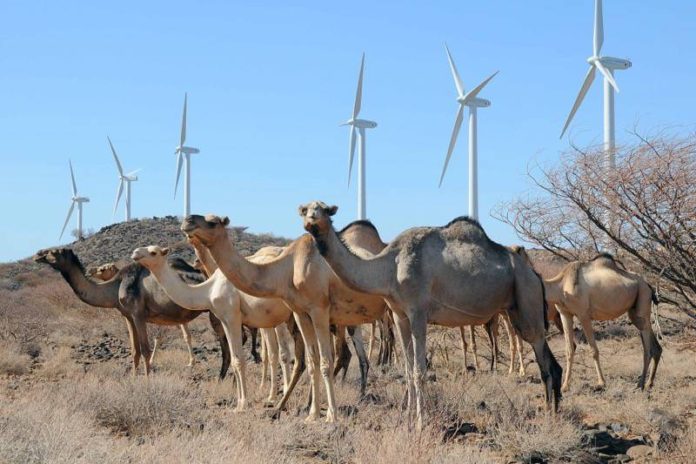Sarima, Marsabit County —In Sarima, a dry, desolate land, traditionally seen as too inhospitable to inhabit in the corner of Kenya’s north sits the country’s largest private investment. Upon completion, it was projected to become Africa’s biggest wind farm project.
For over one year, long trucks were seen carrying strange-looking cargo as they made their way into what was a barren landscape just ten years ago.
The pastoralist inhabitants of Marsabit County say at least two convoys would go along the route every other day. Their destination is a field of 365 powerful wind turbines strategically placed along with one of the windiest corridors in Kenya.
Set in the remote north of Kenya, 700 km from the capital Nairobi, the Lake Turkana Wind power (LTWP) is expected to generate some 300mw of clean energy.
Power is transmitted over 428km and six counties away to Suswa in Kenya’s Rift Valley in a transmission line built by a government agency, the Kenya Electricity Transmission Company ( KETRACO).
Africa Development Bank calls it ‘one of the best private investments in Kenya yet. The project is co-owned by among others Vestas and several other Scandinavian investors.
KETRACO had contracted Isolux Corsan, a Spanish company to build a transmission line but a few kilometers into the project, it declared bankruptcy, stalling things temporarily.
To keep the project running, the Kenyan government awarded a Chinese company the responsibility of completing the transmission line.
KP & P Africa BV, a company of Dutch and Kenyan investors and the initiator of the project also owns LTWP Limited.
Community land acquisition raises questions
However, there are some questions on how the Lake Turkana Wind Power Project came to own the land considering that ten years ago when nobody wanted to come here, this was ancestral land for pastoral communities.

Sixty-year-old Simon Ekitoye has lived in Sarima all his life. He was among the first beneficiaries of what villagers claim was a lot of promises of jobs that the development would bring to Sarima.
“They employed me for two and a half years here to supervise the evacuation of villagers and to demarcate land lots for their respective owners,” Ekitoye told Ubuntu Times in an interview.
Ekitoye and a few others helped in mobilizing residents to move the village off the path of the road developed so that developers could access the site, this happening alongside compensation for their homes.
Sarima village was relocated in 2014, moving 1km away from its original location to pave way for an access road to the project’s site.
The people of Sarima village are part of the indigenous community that calls the Sarima hills and plains their homes.
Original residents like Ekitoye claimed that they were each paid $100 to rebuild their homes. This community, having seen little development since before Kenya’s independence, was keen on advancing itself.
“They promised to build schools, hospitals, provide us employment and plenty of water. In the end, they only dug us one borehole,” says Ekitoye.
Lack of formal education means no permanent employment for locals. Patrick Ole Kaunga, a human rights activist, says LTWP is a highly technical project that does not rely on unskilled manpower to run.
Ole Kaunga says LWTP representatives first approached the Municipal Council of Marsabit in 2007, seeking 40,000 acres of land for the project. Then they asked for a further 110,000 acres which they claim was for ‘future development’.
“The case that the community has confronted since 2014 has been how 150,000 acres of community land was alienated.,” Amina Hashi, a community land lawyer, said in an interview.
According to Ole Kaunga, the board of a divisional land was never set up to consult with the community. Instead, the Marsabit County Council town planning committee was the body that approved the leasing of 150,000 acres of land to LTWP.
But on his part, Charles Keter, the Cabinet Secretary for Energy disputes claims that the community was never consulted before the communal land take-over for the establishment of the Ksh. 70 billion wind power project.
For Hashi, her client’s concern is simple: how did the investor acquire the land?’ A question she says has never been answered in court.
“This was never given the prominence we thought it deserved it being an environment and land court whose specific mandate is to address the land question,” says Hashima.
An influx of people leads to environmental hazards
Before the establishment of LTWP, Sarima was a much smaller village but has grown from under 500 to over 1500 residents as people move in to look for jobs and businesses.
There has been a change in Sarima though. According to Ole Kaunga, when one looks around, there is a lot of business.
“Every small hut is a pub or a shop. It tells you money is circulating. On the other hand, the level of alcoholism has increased. There are even prostitutes. It is not the Sarima we used to know,” laments Ole Kaunga.

Josphine Ngumi runs a bar at the far end of this tightly packed village. She shares the same concerns as Ekiteiyo as well as the same hopes.
“There are no hospitals. They said they would build some, but they have not. They built a school but there are no teachers. The children return home without having been taught,” Ngumi told Ubuntu Times.
Once complete, the 365 wind turbines would catapult Kenya into a league of clean energy producers, a rare status for an African nation.
“We were not exposed to alcohol but when these people moved here their employees introduced alcohol and soft drinks. They even made their own alcohol,” says Ekiteiyo.
Ekiteiyo’s worry would be for his source of livelihood, the livestock saying garbage piles and plastic threaten to kill animals.
This story was written as part of the Sustainable Energy for All fellowship, by Climate Tracker and Hivos.

